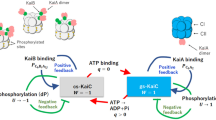Abstract
A non-autocatalytic mathematical model of self-oscillations in vitro in solutions of cyanobacterial Kai proteins (KaiA, KaiB, KaiC) and ATP is suggested. This model describes the process of phosphorylation/dephosphorylation of KaiC protein, which is accelerated by KaiA and inhibited by KaiB. The method of metabolic control analysis is used to show that frequency (period) as well as amplitude of self-oscillations of components of Kai proteins are temperature-compensated.
Similar content being viewed by others
References
Buenning, E. (1973) The Physiological Clock, 3rd Edn., Springer-Verlag, New York.
Golden, S. S., Ishiura, M., Johnson, C. H., and Kondo, T. (1997) Cyanobacterial circadian rhythm, Annu. Rev. Plant Physiol. Plant Mol. Biol., 48, 327–354.
Iwasaki, H., and Kondo, T. (2000) The current state and problems of circadian clock studies in cyanobacteria, Plant Cell Physiol., 41, 1013–1020.
Ishiura, M., Kutsuna, S., Aoki, S., Iwasaki, H., Andersson, C. R., Tanabe, A., Golden, S. S., Johnson, C. H., and Kondo, T. (1998) Expression of a gene cluster kaiABC as a circadian feedback process in cyanobacteria, Science, 281, 1519–1523.
Tomita, J., Nakajima, M., Kondo, T., and Iwasaki, H. (2005) No transcription translation feedback in circadian rhythm of KaiC phosphorylation, Science, 307, 251–254.
Nakajima, M., Imai, K., Ito, H., Nishiwaki, T., Murayama, Y., Iwasaki, H., Oyama, T., and Kondo, T. (2005) Reconstitution of circadian oscillation of cyanobacterial KaiC phosphorylation in vitro, Science, 308, 414–415.
Nishiwaki, T., Iwasaki, H., Ishiura, M., and Kondo, T. (2000) Nucleotide binding and autophosphorylation of the clock protein KaiC as a circadian timing process of cyanobacteria, Proc. Natl. Acad. Sci. USA, 97, 495–499.
Xu, Y., Mori, T., and Johnson, C. H. (2003) Cyanobacterial circadian clockwork: roles of KaiA, KaiB and the kaiBC promoter in regulating KaiC, EMBO J., 22, 2117–2126.
Wang, Z.-X., and Wu, J.-W. (2002) Autophosphorylation kinetics of protein kinases, Biochem. J., 368, 947–952.
Iwasaki, H., Nishiwaki, T., Kitayama, Y., Nakajima, M., and Kondo, T. (2002) KaiA stimulated KaiC phosphorylation in circadian timing loops in cyanobacteria, Proc. Natl. Acad. Sci. USA, 99, 15788–15793.
Kitayama, Y., Iwasaki, H., Nishiwaki, T., and Kondo, T. (2003) KaiB functions as an attenuator of KaiC phosphorylation in the cyanobacterial circadian clock system, EMBO J., 22, 2127–2134.
Iwasaki, H., Taniguchi, Y., Ishiura, M., and Kondo, T. (1999) Physical interactions among circadian clock proteins KaiA, KaiB and KaiC in cyanobacteria, EMBO J., 18, 1137–1145.
Kageyama, H., Kondo, T., and Iwasaki, H. (2003) Circadian formation of clock protein complexes by KaiA, KaiB, KaiC, and SasA in cyanobacteria, J. Biol. Chem., 278, 2388–2395.
Egli, M., Pattanayek, R., and Pattanayek, S. (2008) Protein–protein interactions in the cyanobacterial KaiABC circadian clock, in Models, Mysteries and Magic of Molecules (Boeyens, J. C. A., and Ogilvie, J. F., eds.) Springer, Dordrecht, pp. 283–299.
Mehra, A., Hong, C. I., Shi, M., Loros, J. J., Dunlap, J. C., and Ruoff, R. (2006) Circadian rhythmicity by auto-catalysis, PLoS Comput. Biol., 2, e96.
Ivanova, A. N. (1979) Conditions for existence of the only steady state in kinetic systems, related with the structure of reaction scheme, Kinet. Katal., 20, 1019–1028.
Bayramov, Sh. K. (2002) Simple critical schemes in non-autocatalytic systems of biochemical reactions, Biochemistry (Moscow), 67, 761–764.
Dunlap, J. C. (1999) Molecular bases for circadian clocks, Cell, 96, 271–290.
Author information
Authors and Affiliations
Corresponding author
Additional information
Original Russian Text © Sh. K. Bayramov, 2016, published in Biokhimiya, 2016, Vol. 81, No. 3, pp. 410–415.
Rights and permissions
About this article
Cite this article
Bayramov, S.K. Mathematical model of self-oscillations of activity of Kai proteins. Biochemistry Moscow 81, 284–288 (2016). https://doi.org/10.1134/S0006297916030111
Received:
Revised:
Published:
Issue Date:
DOI: https://doi.org/10.1134/S0006297916030111



